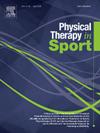Competitive swimming and shoulder adaptations: The role of stroke specialty in adolescent swimmers
IF 2.2
3区 医学
Q1 REHABILITATION
引用次数: 0
Abstract
Objectives
To examine sport-specific adaptations and the influence of stroke specialization on the shoulder complex among adolescent competitive swimmers.
Design
Cross-sectional study.
Setting
Athletic facilities.
Participants
76 adolescents (14.3 ± 1.3 years), including 28 non-swimmers (Control Group, CG) and 48 competitive swimmers (Swimmers Group, SWG).
Main outcome measures
Strength of glenohumeral (GH) and scapular muscles (SM), GH joint mobility (GH ROMs), proprioception, pectoralis minor length (PML), and posterior shoulder tightness (PST) were evaluated. The Kerlan-Jobe Orthopaedic Clinic (KJOC) Score was used to evaluate shoulder function in the SWG. A tested shoulder physical performance parameters were compared between the groups.
Results
Comparisons showed that all GH, SM strength measures and PML were higher in the SWG (p < 0.05). GH ER/IR ratio was lower in SWG (MD = 0.8–0.11 N, p < 0.05). GH ROM comparisons revealed decreased IR and increased ER and total rotational ROM in the SWG (p < 0.05). No differences in proprioception or PST were found (p > 0.05). Additionally, no significant differences were observed when all parameters were compared among SWG subgroups based on stroke specialization (p > 0.05).
Conclusions
Adolescent competitive swimmers exhibited sport-specific, but not stroke-specific, adaptations in the shoulder complex.
竞技游泳和肩部适应:中风专长在青少年游泳运动员中的作用
目的探讨青少年竞技游泳运动员的运动适应性及卒中专业化对肩部复合体的影响。DesignCross-sectional研究。SettingAthletic设施。参与者76名青少年(14.3±1.3岁),其中非游泳者28人(对照组,CG),竞技游泳者48人(游泳者组,SWG)。主要观察指标:评估肱骨肩胛肌(GH)和肩胛肌(SM)的强度、肩胛肌关节活动度(GH ROMs)、本体感觉、胸小肌长度(PML)和后肩紧度(PST)。采用Kerlan-Jobe骨科临床评分(KJOC)评估SWG患者的肩关节功能。比较两组间测试的肩部物理性能参数。结果SWG组GH、SM强度指标和PML均高于对照组(p <;0.05)。SWG组GH ER/IR比较低(MD = 0.8-0.11 N, p <;0.05)。GH ROM比较显示,SWG的IR降低,ER和总旋转ROM增加(p <;0.05)。本体感觉和PST未见差异(p >;0.05)。此外,在基于脑卒中专门化的SWG亚组之间比较所有参数时,没有观察到显著差异(p >;0.05)。结论:青少年竞技游泳运动员在肩部复合体上表现出运动特异性的适应性,而不是泳姿特异性的适应性。
本文章由计算机程序翻译,如有差异,请以英文原文为准。
求助全文
约1分钟内获得全文
求助全文
来源期刊

Physical Therapy in Sport
医学-康复医学
CiteScore
4.50
自引率
8.30%
发文量
125
审稿时长
39 days
期刊介绍:
Physical Therapy in Sport is an international peer-reviewed journal that provides a forum for the publication of research and clinical practice material relevant to the healthcare professions involved in sports and exercise medicine, and rehabilitation. The journal publishes material that is indispensable for day-to-day practice and continuing professional development. Physical Therapy in Sport covers topics dealing with the diagnosis, treatment, and prevention of injuries, as well as more general areas of sports and exercise medicine and related sports science.
The journal publishes original research, case studies, reviews, masterclasses, papers on clinical approaches, and book reviews, as well as occasional reports from conferences. Papers are double-blind peer-reviewed by our international advisory board and other international experts, and submissions from a broad range of disciplines are actively encouraged.
 求助内容:
求助内容: 应助结果提醒方式:
应助结果提醒方式:


